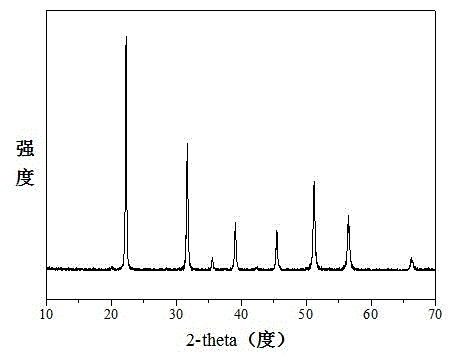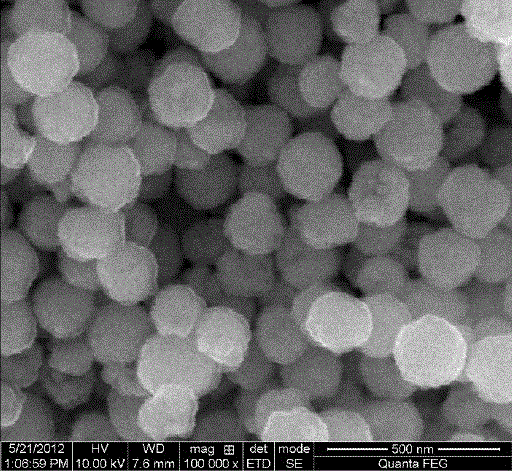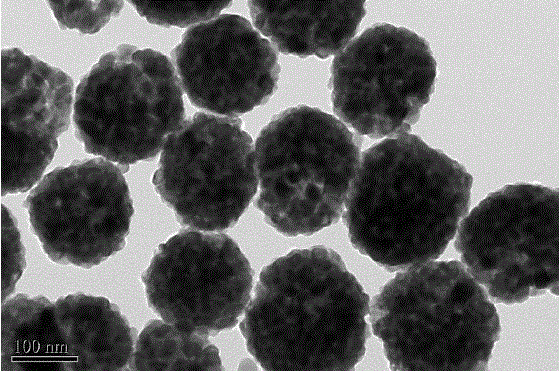Method for preparing monodisperse indium oxide nanometer porous microsphere
A nanoporous, indium oxide technology, applied in chemical instruments and methods, nanotechnology, inorganic chemistry, etc., can solve the problems of difficult large-scale production, complex process, high cost, and achieve simple production equipment and large specific surface area. , the effect of convenient operation
- Summary
- Abstract
- Description
- Claims
- Application Information
AI Technical Summary
Problems solved by technology
Method used
Image
Examples
Embodiment 1
[0018] (1) Mixing and stirring: use indium trichloride tetrahydrate as raw material, dissolve in deionized water to make a solution of 0.02 mol / liter, and then follow the molar ratio of indium trichloride tetrahydrate: citric acid as 1:3 Ratio, add citric acid as an additive, stir and mix evenly, and then add urea as a precipitant according to the ratio of indium trichloride tetrahydrate: urea molar ratio of 1:10, stir magnetically for 10 minutes, and mix evenly;
[0019] (2) Hydrothermal reaction and solid-liquid separation: move the mixed solution in step (2) to a hydrothermal reaction kettle lined with polytetrafluoroethylene, conduct hydrothermal reaction at 130°C for 12 hours, and then The product after the hydrothermal reaction is separated from solid and liquid by a centrifuge, and the obtained solid product is washed several times with deionized water and ethanol;
[0020] (3) Drying and calcination: the solid product obtained in step (3) was placed in a drying oven, d...
Embodiment 2
[0022] (1) Mixing and stirring: use indium trichloride tetrahydrate as raw material, dissolve it in deionized water to make a solution of 0.1 mol / liter, and then follow the molar ratio of indium trichloride tetrahydrate: citric acid as 1: 6 Ratio, add citric acid as an additive, stir and mix evenly, then add urea as a precipitating agent according to the ratio of indium trichloride tetrahydrate: urea molar ratio of 1: 20, stir magnetically for 10 minutes, and mix evenly;
[0023] (2) Hydrothermal reaction and solid-liquid separation: move the mixed solution in step (2) to a hydrothermal reaction kettle lined with polytetrafluoroethylene, and conduct a hydrothermal reaction at 140°C for 18 hours, then The product after the hydrothermal reaction is separated from solid and liquid by a centrifuge, and the obtained solid product is washed several times with deionized water and ethanol;
[0024] (3) Drying and calcination: the solid product obtained in step (3) was placed in a dryi...
Embodiment 3
[0026] (1) Mixing and stirring: use indium trichloride tetrahydrate as raw material, dissolve in deionized water to make a solution of 0.04 mol / liter, and then follow the molar ratio of indium trichloride tetrahydrate: citric acid as 1:5 Ratio, add citric acid as an additive, stir and mix evenly, and then add urea as a precipitant according to the ratio of indium trichloride tetrahydrate: urea molar ratio of 1:15, stir magnetically for 10 minutes, and mix evenly;
[0027] (2) Hydrothermal reaction and solid-liquid separation: move the mixed solution in step (2) to a hydrothermal reaction kettle lined with polytetrafluoroethylene, conduct hydrothermal reaction at 150°C for 18 hours, and then The product after the hydrothermal reaction is separated from solid and liquid by a centrifuge, and the obtained solid product is washed several times with deionized water and ethanol;
[0028] (3) Drying and calcination: the solid product obtained in step (3) was placed in a drying oven, d...
PUM
| Property | Measurement | Unit |
|---|---|---|
| specific surface area | aaaaa | aaaaa |
Abstract
Description
Claims
Application Information
 Login to View More
Login to View More - R&D
- Intellectual Property
- Life Sciences
- Materials
- Tech Scout
- Unparalleled Data Quality
- Higher Quality Content
- 60% Fewer Hallucinations
Browse by: Latest US Patents, China's latest patents, Technical Efficacy Thesaurus, Application Domain, Technology Topic, Popular Technical Reports.
© 2025 PatSnap. All rights reserved.Legal|Privacy policy|Modern Slavery Act Transparency Statement|Sitemap|About US| Contact US: help@patsnap.com



